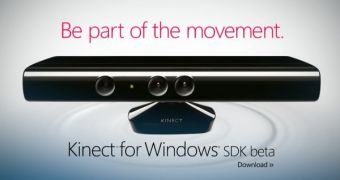Microsoft has just released the official Kinect software development kit (SDK) for Windows-based PCs, effectively allowing Kinect owners to tinker and create applications for the PC that employ the new device.
Microsoft's Kinect motion and voice detection sensor has been a huge success, managing to become the world's fastest selling electronics device by moving over 10 million units since its release last year.
Even if the Kinect was officially supported just by Microsoft's Xbox 360 console, developers and enthusiasts quickly compiled a set of open source drivers that allowed the Kinect to communicate with the PC, thus enabling some rather unique projects to appear, including playing World of Warcraft or many other games with just the Kinect.
Seeing the massive potential, Microsoft promised earlier this year that an official SDK will be released, and has now deployed the beta version of the Kinect devkit.
"The Kinect for Windows SDK beta is a programming toolkit for application developers," Microsoft has revealed. "It enables the academic and enthusiast communities easy access to the capabilities offered by the Microsoft Kinect device connected to computers running the Windows 7 operating system."
Plenty of major features are included in the Kinect for Windows SDK, ranging from drivers, enhanced APIs for raw sensor streams, as well as plenty of documents and resource materials that can be read by all aspiring developers, who are familiar with programming languages like C++, C# or Visual Basic.
Check out a list of Kinect for Windows SDK features below.
Raw sensor streams -Access to raw data streams from the depth sensor, color camera sensor, and four-element microphone array enables developers to build upon the low-level streams that are generated by the Kinect sensor. Skeletal tracking -The capability to track the skeleton image of one or two people moving within the Kinect field of view make it easy to create gesture-driven applications. Advanced audio capabilities -Audio processing capabilities include sophisticated acoustic noise suppression and echo cancellation, beam formation to identify the current sound source, and integration with the -Windows speech recognition API. Sample code and documentation -The SDK includes more than 100 pages of technical documentation. In addition to built-in help files, the documentation includes detailed walkthroughs for most samples provided with the SDK. Easy installation -The SDK installs quickly, requires no complex configuration, and the complete installer size is less than 100 MB. Developers can get up and running in just a few minutes with a standard standalone Kinect sensor unit (widely available at retail outlets). This Kinect SDK is designed for non-commercial purposes, as Microsoft says that a commercial version designed to create Kinect-based experiences just for the PC will appear at a later time.
The Kinect for Windows PC SDK is now available for download right now from Softpedia.

 14 DAY TRIAL //
14 DAY TRIAL //